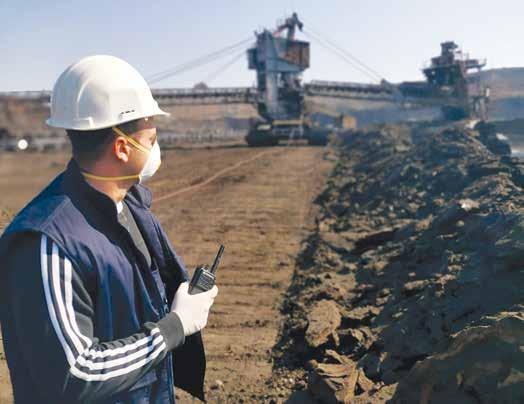
10 minute read
OVERCOMING THE CRISIS TOGETHER
Regarding the current situation caused by the Coronavirus pandemic, the Chamber of Commerce and Industry of Serbia and the USAID project Cooperation for Growth conducted two iterations of the online survey “Overcoming the Crisis Together”, dedicated to Serbian businesses and entrepreneurs. The questionnaire focuses on the economic consequences of the crisis and its impact on doing business
The goal of the survey is to provide a quick and valid overview of the state of the economy, during and after the outbreak of the crisis, and convey businesses’ attitudes related to the effects of the crisis, opportunities to adjust business models to a significantly changed environment, measures businesses have taken, as well as measures applied by state authorities to sup port the private sector.
Advertisement
“The findings of the survey are valuable because they are “mirroring” the state of the economy and the reactions of businesses in the seventh week from the day of the decla ration of the state of emergency. We would like to express our sincere gratitude to all businesspeople and entrepreneurs who partic ipated in the survey. Representatives of 806 businesses participated in the first iteration of the survey, conducted in the last week of March – the third week after the beginning of the crisis. The second phase of the survey was conducted at the end of April, in the seventh week since the outbreak of the crisis, with the participation of 1,000 businesses,” said Dragana Stanojević, Chief of Party at USAID’s Cooperation for Growth project.
After seven weeks of the crisis, the strong -
est effects impacting adversely on businesses are working time limitations and work from home, an inability to cover underlying costs, and a lack of contact with clients. This is fol lowed by an inability to collect domestic claims from the private sector, postponements and cancellations of orders, as well as difficulties in transport and logistics. The findings underline the sensitivity of the private sector to liquidity, as well as to workforce optimisation, including working remotely.
Tourism and hospitality stand out as the hardest hit business sector, followed by the creative industry, transport and the storage industry.
Findings show that every other business has organised work from home for part of their employees (51% of respondents). Firms have also reduced working hours (43%), while every third business has started negotiations with creditors about delaying debt repayment (31%). Results also show that 20% of respondents have partially closed business operations, while 14,6% of them opted to halt all business operations temporarily.
“It is interesting to emphasise that around one-fifth of respondents (21,2%) have changed their business model/production algorithm, so we can conclude that some of the Serbian businesses have been better prepared to face this unpredicted situation, adapting more easily and facing necessary changes more courageously,” explained Stanojević.
Although the crisis has had a drastic im pact on decreasing capacities for production and/or services, 60% of respondents, the majority of firms have not decided to lay off employees, while the absolute majority of them have maintained the same number of employees they had before the crisis (85%). An encouraging fact is that a quarter of businesses have already recovered par tially (26%), while 12% of companies have already reached the same level of business performance they’d achieved before the crisis. Every third company can adapt, partially (26%) or completely (5%), to online business. However, most respondents (2/3 of them) need physical space to do business, due to the nature of their operations. Representa
It is interesting to emphasise that around one-fifth of respondents (21.2%) have changed their business model/ production algorithm, so we can conclude that some of the Serbian businesses have been better prepared to face this unpredicted situation, adapting more easily and facing necessary changes more courageously
tives of around four per cent of enterprises cited financial or other barriers in switching to an online business model. If we look at this finding by firm size, entrepreneurs and micro-businesses can more easily switch to online operations than larger companies. A web presence and eCommerce are glob ally proved as important levers of growth (even before the crisis) and as basic “survival” tools in the crisis caused by Covid-19. According to the survey, Serbian businesses are aware of the importance of an internet presence – 85% of them already have a webpage or plan to create one. Having an online presence is partially determined by the size of the company. Every other entrepreneur is present on the internet, while practically all medium-sized and large enterprises have a website. This fact clearly emphasised the importance of being present on the web and sends a strong message to small enterprises that it is almost impossible to manage a business without an online presence. It is noteworthy that a significant number
DRAGANA STANOJEVIĆ

of micro-enterprises and entrepreneurs that do not yet have webpages plan to launch them (17.6% and 20/5% respectively). This once again shows that micro and small enterprises understand that the internet is a unique space that may provide them with an opportunity to compete for their web presence, increasing their visibility and attracting customers incurring considerably lower costs compared to the traditional offline businesses.
The sectors with an above-average pres ence on the internet include the creative industry, the industry of non-food products, IT, tourism and hospitality. However, every other company in agriculture and construction, as traditional sectors, has a webpage and an online presence. It is concerning to a certain extent that food and beverage production and agriculture are not sufficiently present online, as they sustained a huge hit as a result of the Coronavirus and quarantine, when having an online presence was the only way for them to promote themselves, find consumers and July
partially compensate for interruptions in supply and distribution chains. This result additionally highlights the need for systemic solutions, such as unique food marketplaces.
The number of eCommerce firms in Serbia is on the rise (via their webshop/or via “third party” webshops) and amounts to around 20%, compared to 12% recorded in the Business Survey conducted by USAID’s Cooperation for Growth project last year.
“It is an encouraging fact that many en terprises offer e-banking and m-banking (85.6%). However, only 12% of respondents offer some type of card payment – whether it is direct payment or payment on delivery. This has been very important during and after the crisis caused by Covid-19, because cashless payments are much safer compared to cash payments,” insists Stanojević.
A small percentage of firms (16%) offer more than one payment method to their clients. In all transactions, especially in B2C ones, the most optimised eCommerce offers all types of payment methods to customers. If firms do not offer this option, they lose customers. 28

However, it is assumed that a significant sec tion of respondents in this survey are related to B2B eCommerce, for which e-banking is an optimal payment option.
Businesses from the Belgrade area are engaged in eCommerce at a level above average compared to firms from other regions.
According to size, entrepreneurs and micro enterprises were the hardest hit. According to sector, tourism and hospitality, the creative industries and transport are the worst affected. The crisis has deepened – the most common estimated recovery time is from three to six months, followed by six to 12 months.
Following the first phase of the crisis, every other company said it believed its operating revenues had at least halved compared to the same month last year. However, the per centage of businesses expecting a huge loss exceeding 80% declined slightly compared to the beginning of the crisis, amounting to 23%.
Observing the losses estimated for 2020 compared to the 2019, larger companies estimated smaller losses. Only 13% of large enterprises estimate a loss of more than 80%. On the other hand, entrepreneurs and micro enterprises stand out as being particularly hard hit: a third of them estimate a loss exceeding 80%. When it comes to sectors of activity, the biggest losses compared to the same month last year were recorded in tourism and hospitality (75% estimated a loss exceeding 80%), but also in the creative industries, as well as transport, storage and trade.
When it comes to businesses’ expectations of the economic impact of the Coronavirus outbreak on falling sales in 2020, as com pared to 2019, the number of those who say
they expect more than a twofold reduction in sales declined slightly. It comes as no surprise that the most severe consequences for sales are expected by the tourism and hospitality sectors, the creative industries, and transport and storage. What is a new is that the worst affected sectors are followed by the IT sector, which, along with transport, indicates that the decline in the performances of sectors hit severely and immediately by the crisis is now impacting other sectors within the value chains.
A third of companies will need three to six months to recover, with larger companies recovering faster.
The absolute majority of companies (91%) still expect difficulties in fulfilling their obligations. After the first phase of the crisis, every other firm expected to have difficulties fulfilling their obligations for up to 60 days, now, in the seventh week, firms perceive that those liquidity problems will last 90 days or more, indicating that the duration of the crisis has hit the economy deeper and recovery will take longer.
In the seventh week of the crisis, businesses estimated that, on average, they will need more time to recover than was estimated at the very beginning. Assuming that the crisis ended in the last days of April, a third of companies believe that they will recover in a period of 6 to 12 months (22%) or a period longer than 12 months (8%). About 30% of companies believe that they need 3 to 6 months to recover, while about 10% of companies estimate that they could recover in a month. When it comes to large companies, as many as 19% think that a month is enough to recover.
Businesses are showing great interest in state aid measures: 64% have already applied, a quarter plan to do so and only 10% are not interested at all. The most vulnerable sectors applied first for some of the packages of economic measures. According to company representatives, the most useful measures are direct assistance to the MSME sector through the payment of the minimum wage (76% of companies rate this as useful), de ferrals of payments of taxes on earnings and contributions (69%), deferrals of advanced payments (61%), and guarantee schemes for
supporting the economy (53%).
It is important to note that a significant number of entrepreneurs (from 10 to 14%) need additional assistance in using state aid measures, which indicates that any practical and educational support that could be offered to companies by business associations, inter national organisations or state institutions is welcome.
The decline in the transport, tourism and industrial sectors significantly affects the decline in other businesses in terms of their supply/value chains.
“Overcoming the crisis is not a phenom enon that can be observed individually. Generally, the business of one company is part of one or more supply chains/values, so the speed of recovery of a particular company should be observed in terms of the intensity of the impact on other enterprises in the chain,” explains Stanojević.
Most firms, two-thirds of them, are im pacted with changes in their operations by up to 30 other firms in the supply chain moving backwards (their B2B suppliers), and by up to

100 other firms in the supply chain moving for wards (their B2B customers). However, some companies are highly intensively connected with other companies: 10% of them have more than 150 suppliers, while a quarter of them place products and services for more than 150 other companies.
Transport, tourism, and industry stand out as the sectors with the largest share of companies that, through changes to their operations, directly or indirectly impact on the business operations of other companies within supply/value chains, which indicates that we can expect a second wave of the economic crisis over time
The USAID project Cooperation for Growth, in cooperation with the Chamber of Commerce & Industry of Serbia, will con tinue to monitor the Serbian economy and all consequences caused by the Coronavirus crisis. At the beginning of the July we will publish the findings of the third iteration of the survey, which will focus on the obstacles that businesses see obstructing their road to recovery. ■










